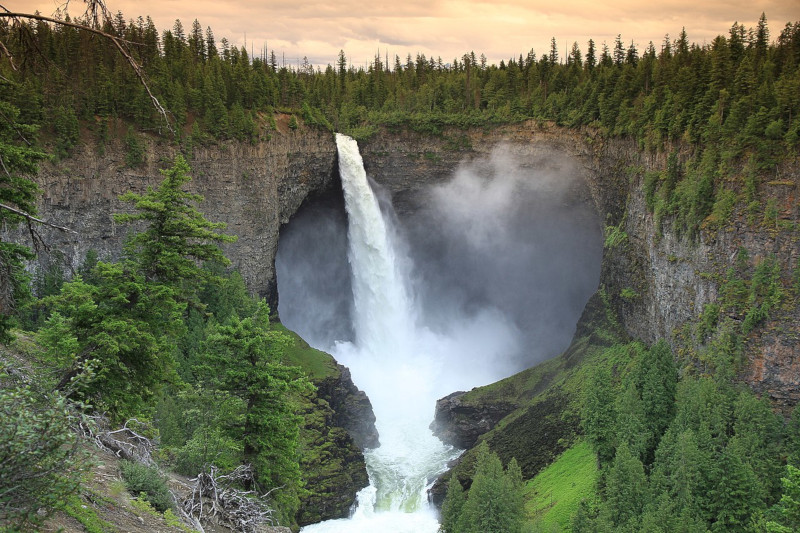
Helmcken Falls Facts
- Perhaps most notably, the term of Helmcken Falls represents the name of a particularly visually stunning waterfall. In point of fact, its remarkable beauty also served as one of the underlying reasons for the creation of an entire park.
- Further, this site bears the name of the Wells Gray Provincial Park. In addition, this beautiful site also holds a very respectable status for its many physical statistics. These serve to make it one of the great wonders nearly unknown outside of its area.
- This statement holds true due to the fact that it ranks as the fourth highest waterfall found in the country in which it formed. This remains especially notable since the gorgeous cascade consists of only a single, completely impressive drop.
- It currently remains unknown whether the Indigenous Peoples of the region knew of its existence, or not. However, the credit for the discovery of the site by a non-native generally goes to a land surveyor, named Robert Henry Lee.
- This extremely fortuitous discovery occurred accidentally, on July 24, 1913. However, it obviously does not bear his name, despite his place in history. The magnificent Helmcken Falls bears its present name in honor of John Sebastien Helmcken.
- This individual was a prominent physician who arrived in the general region shared by the falls in the year 1850. Finally, today, the stunning site quite understandably represents one of the most popular tourists sites in its part of the globe.
Related Articles
Helmcken Falls Physical Description
It’s not the highest waterfall in the world. But, the gorgeous Helmcken Falls remains a particularly imposing feature of Nature. Further, this holds true due to more than its obvious beauty. Aside from its purely visual appeal, its vital statistics are worthy of appreciation.
Firstly, the cascade, forming part of the Murtle River, closely follows another fall. But that one does not rank as impressive as our subject. In fact, this waterfall plunges an admirable 462 ft (141 m), in a single plunge, from the relatively narrow lip of the canyon above.
Secondly, Helmcken Falls boasts other remarkable statistics. Though its width naturally varies, depending upon the seasons and rainfall levels, this averages 50 ft (15 m). During periods of peak inflow, this measurement sometimes increases to as much as 75 ft (23 m).
Thirdly, at its base lies another incredible natural feature. Located just behind the base of the plunge, lies a natural amphitheater. This feature, carved out by the waterfall, extends roughly 150 ft (46 m) back into the cliff. It also has a remarkable width of about 500 ft (152 m).
Helmcken Falls Location and Formation
The truly magnificent site commonly known as Helmcken Falls formed in a part of the world already well known for its abundance on natural beauty. That’s due to the fact that it formed in an especially lovely portion of the continent of North America.
Even more precisely, the stunning waterfall lies situated within the east-central region of the province of British Columbia, in the country of Canada. This comparatively enormous plateau, itself a wonder of nature, formed somewhat violently, roughly 200,000 years ago.
That formation occurred as the result of an extensive, long-term period of steady volcanic activity. It qualifies as long-term due to the fact that it flowed slowly through fissures in the earth in the area. Unfortunately for science, the exact duration remains undetermined.
However, the lava itself eventually piled up in the region. This deposited to an incredible depth of about 820 ft (250 m). Later, though, incredibly large and powerful floods later carved a path through the layers of deposited lava that formed the plateau.
Additionally, this flooding action occurred at the end of the last ice age. More specifically, though, this happened roughly 10,000 years ago. The water volume of Helmcken Falls itself originated from the melting glaciers covering the much of the region.
Features Sharing Its Region
Check out our other articles on 6 Extraordinary North American Reptiles, Australian Ghost Shark, Little Auk, Reynisfjara Beach, Dawn Redwood, Marbled Cat, Southern Flannel Moth
